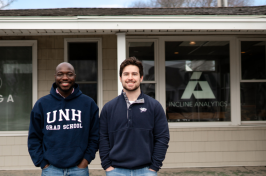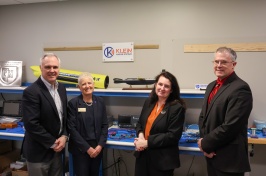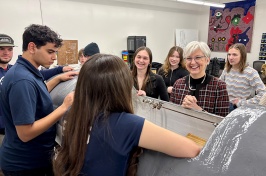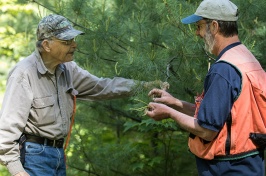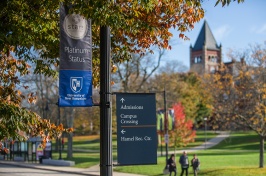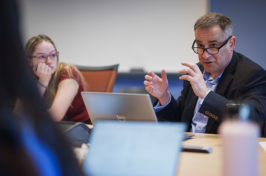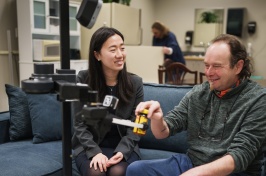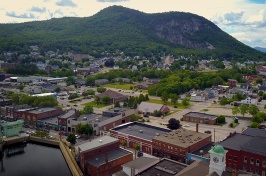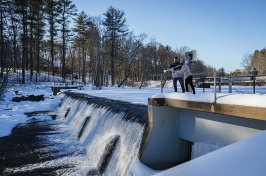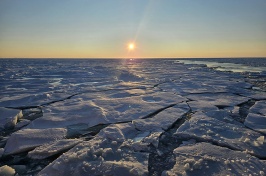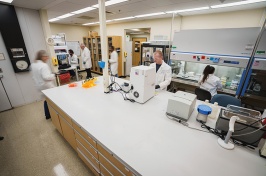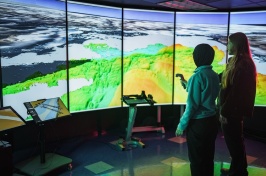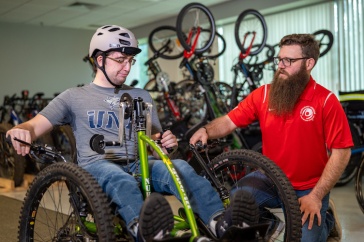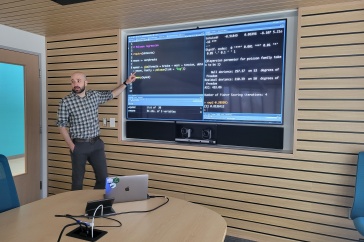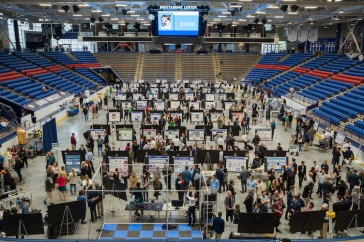
On Nov. 13, 1985, Nevado del Ruiz erupted in Colombia. As eruptions go, it was small. But it was also deadly. Approximately 23,000 people died and the entire town of Armero was destroyed, not by hot lava but by rivers of mud the consistency of wet concrete that came roaring down steep mountain valleys like freight trains, picking up trees, boulders and speed before converging on the town more than 40 miles away.
Nevado del Ruiz was the second most deadly volcanic event of the last century. Only Mt. PelŽe, on the Caribbean island of Martinique, was worse, claiming 29,000 lives when it destroyed the capital city, St. Pierre, in 1902.
Of the roughly 1,500 active volcanoes on earth, between 50 and 70 erupt in any given year. Worldwide, approximately 500 million people live in volcano danger zones. UNH volcanologist Jeff Johnson is working to help them avoid the fate of the residents of Armero and St. Pierre. "Hazard mitigation has been one of my main drives from the beginning," says Johnson, a research assistant professor in the UNH earth sciences department.
Johnson studies the infrasound produced by volcanoes to better understand how they erupt and, as a result, to better predict eruptions. Unlike earthquakes, which give few warning signs before they strike, active volcanoes broadcast acoustic signals—songs, if you will—that can tip off anyone who is listening.

These low-frequency sound waves are a largely untapped resource for volcano monitoring, says Johnson. "I give talks all the time promoting the value of this science," he says, noting that the monitors are relatively inexpensive to install. Officials are starting to take heed. In November, Johnson helped Mexican volcanologists install permanent infrasonic microphones at Volcan de Colima, considered to be the most active and, potentially, the most destructive of nine volcanoes located in central Mexico. Also last year, Johnson built microphones for a permanent network at Mt. Erebus on Ross Island in Antarctica. "For a long time now, we have been installing microphones as part of short-duration geophysical experiments. Now is the time to get permanent installations in place and focus on the interpretation of sound, so that local monitoring officials can use the data to figure out exactly what is going on at their volcano," he says.
Akin to the seismic waves that travel through the ground when the earth quakes, infrasound travels through the air when the atmosphere is disturbed. By definition, infrasound is low frequency (under 20 hertz), so low that humans can't hear it. Whales and elephants can send and hear infrasound, however, and use it to communicate across great distances. Nuclear blasts also produce infrasound, which is why the superpowers listen for it to monitor test bans. Other sources of infrasound include avalanches, meteorites, lightning and waterfalls. Johnson discovered this last source of infrasound serendipitously while recently researching an Ecuadorian volcano that happened to be located near 475-foot San Rafael Falls.

HOT ROCKS: Research assistant professor Jeff
Johnson, above, approaches a lava tube at
Kilauea volcano on the island of Hawaii.
Krakatoa produced the first recorded instance of volcanic infrasound when it erupted in Indonesia in 1883. The powerful explosion created a ripple in the atmosphere that circled the globe seven times: Scientists noticed the corresponding changes in air pressure on their barometers. But using infrasound to study volcanoes is relatively new. In fact, Johnson started out as a traditional seismologist. At Stanford, his first study in the field was collecting data on earthquakes in the Himalayas of Pakistan. While studying volcano-generated earthquakes at the University of Washington, Johnson's fluency in Russian—which he picked up as a foreign-exchange student to the former Soviet Union in 1989—helped land him a spot on three expeditions to the Karymsky volcano on the Kamchatka Peninsula. An advisor suggested he build a microphone to monitor infrasound as a complement to the seismic data.
"Back then, very few people were studying sound from volcanoes," says Johnson. "I figured this was a novel opportunity to use this method to learn how volcanoes erupt." When combined with seismic recordings, infrasound can help volcanologists monitor the frequency, intensity and nature of eruptions over time—information vital to predicting small events, as well as life-threatening eruptions or ash plumes that can bring down jet planes. "There's a lot of rich information in these acoustic signals," says Johnson.

Lava bursts from Mount Etna, near Nicolosi, Italy, in
2001.
His interest in mountaineering and international travel makes field volcanology a natural choice for Johnson. Having hiked all the highest mountains in New Hampshire while still a high school student at Phillips Academy in Andover, Mass., he chose to study abroad in Ecuador because it has so many alpine peaks. It was there that Johnson fell in love with volcanoes. Last summer, supported by the Fulbright Scholars Program and the National Science Foundation, Johnson returned to Ecuador for the ninth time to set up monitors to assess the magnitude of eruptions. Unlike visual assessments, infrasound monitoring can be done when the volcano is cloaked in clouds or darkness. And with the help of wireless networks, it can be done in real time from a safe distance.
Johnson's readings revealed that the ground motion caused by the eruption was 100 times stronger than indicated by the traditional seismic network in place at the volcano, which was saturated by the force of the eruption. "If no one had been doing the measurements, no one would have known about the intensity of this explosion," says Johnson. "There is a real need for this technology in Ecuador, where both a large population and important infrastructure are threatened."
His research has taken him to a dozen active volcanoes and he has visited many more as a "volcano tourist." His favorite is Mt. Erebus in Antarctica, which he calls "the most magical place on the entire Earth. It's an immense volcano with an active summit lava lake that pokes its head above a sea of ice," he says. "In terms of dramatic landscapes, it's unmatched."
Johnson came to UNH in 2004 from a postdoctoral position at the Hawaii Institute of Geophysics and Planetology on the island of Oahu. "It was an easy decision for me to return to New England, where my family lives," he says. "But it was a bit harder to convince my wife, Liz."

Johnson's colleagues approach a bridge on the way to
the Tungurahua volcano in Ecuador.
While studying volcanoes may seem like dangerous work, Johnson says volcanology has an undeserved reputation. More of his colleagues have perished en route to their field work in traffic accidents and climbing mishaps than as a result of volcanic activity. "I don't think the volcano work is any more dangerous than the high-altitude mountaineering I used to do," says Johnson. "I would argue that in many situations, getting to the volcano is the more dangerous aspect of our work."
At UNH, there is a growing expertise in the use of volcanoes to study earth processes. Professor Karen Von Damm, who has a joint appointment in earth sciences and the Institute for the Study of Earth, Oceans and Space, is studying undersea volcanoes known as "black smokers" to help resolve some of the most basic questions about geochemical cycling on the earth's surface. In the earth sciences department, assistant professor Julie Bryce uses the geochemistry of volcanic rocks to study processes deep within the earth, and assistant professor Joe Licciardi studies ancient lava flows to help date geologic events, such as the melting of glaciers in Iceland. Department chair Matt Davis is preparing to study the geochemical contrasts created by ancient volcanic structures in New Hampshire to better understand the flow patterns in fractured bedrock aquifers.

MOUNTAIN VIEW: With Chile's Licancabur volcano in the distance,
volcanologist Jeff Johnson, above, bicycles through a field of
lupines.
Davis says this common expertise in volcanoes has emerged more by chance than by intention and is somewhat surprising, given the absence of active volcanoes in the state. But his department is looking closely at how volcanoes can advance its research program and attract more students to the geological sciences: "Volcanoes tie together several different areas of the department. Their study offers many scientific opportunities as well as outstanding educational opportunities."
Johnson is eager to share his passion for volcanoes with students. He hopes future courses in volcanology will pave the way for UNH field trips to recently active volcanoes during summer or spring breaks. "Volcanology is a sexy aspect of geology because it gives us the rare opportunity of seeing geologic change happen before our eyes," he says. "I got into geology because of my field experiences and, from my perspective, that's the best way to get students excited about earth sciences."
Robert Emro is the science writer for UNH's College of Engineering and Physical Sciences.







